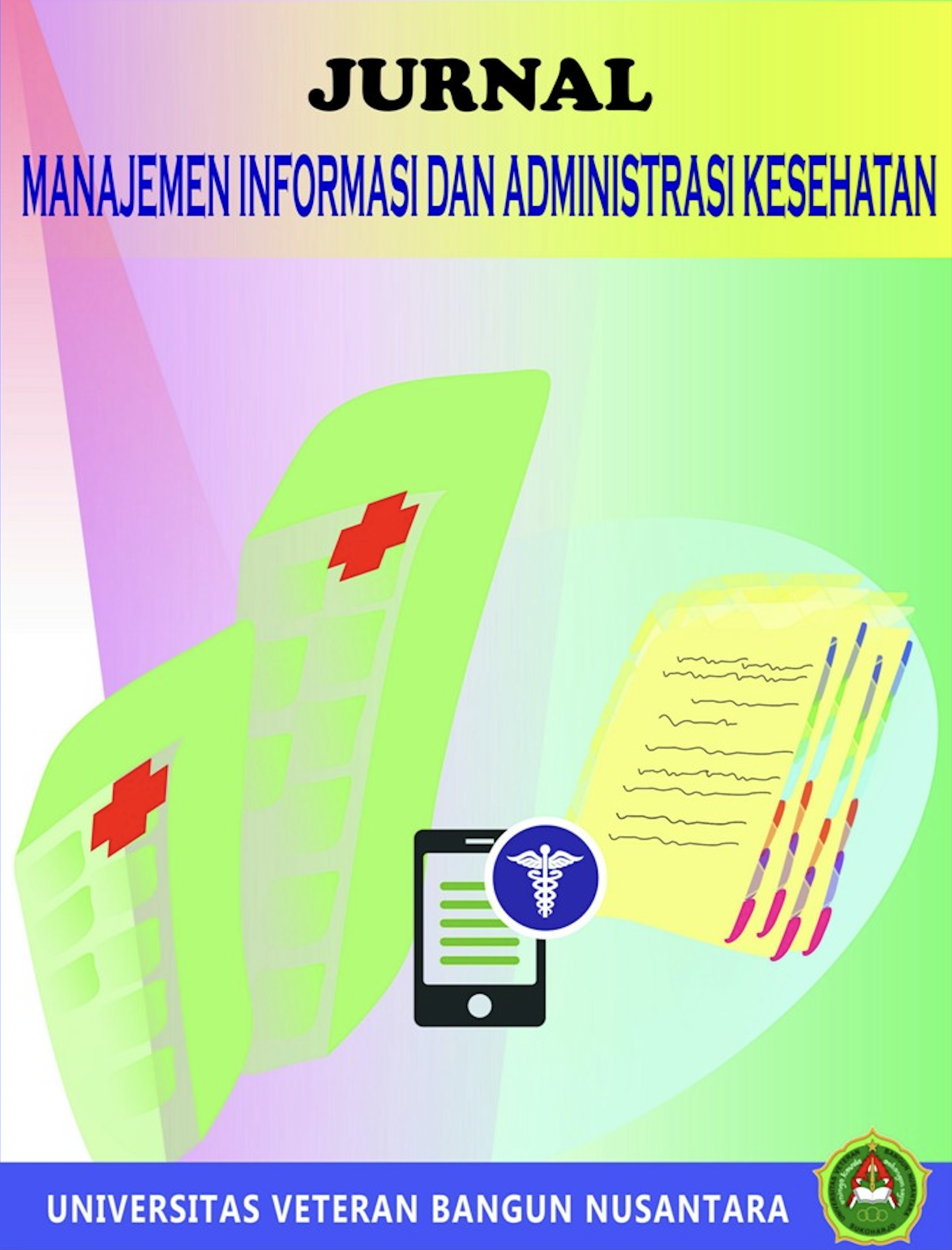ANALISIS PENGGUNAAN SISTEM INFORMASI PUSKESMAS DI PUSKESMAS PANGGANG II GUNUNG KIDUL
DOI:
https://doi.org/10.32585/jmiak.v5i1.2512Keywords:
SIMPUS, PuskesmasAbstract
Perkembangan teknologi dan Informasi telah merambah kesemua bidang termasuk bidang kesehatan. Puskesmas sebagai salah satu fasilitas pelayanan kesehatan primer ikut memanfaatkan perkembangan teknolgi dan informasi melalui implementasi SIMPUS. Pemanfaatan SIMPUS bertujuan untuk memudahkan tugas dan pekerjaan pengguna khususnya dalam pelayanan kesehatan sehingga dapat meningkatkan mutu pelayanan. Penelitian ini bertujuan untuk mengevaluasi sistem informasi puskesmas (SIMPUS) di Puskesmas Panggang II Gunung Kidul untuk mengetahui optimalisasi dan efektivitas pemanfaatan SIMPUS serta mengetahui hambatan dan kendala implementasi SIMPUS agar sesuai dengan tugas dan pekerjaan pengguna SIMPUS di Puskesmas Panggang II Gunung Kidul.
Penelitian ini termasuk dalam penelitian kualitatif observasional dengan pendekatan fenomenologi. Instrumen penelitian adalah pedoman wawancara dan lembar observasi, teknik pengambilan data dilakukan dengan wawancara kepada informan penelitian yang berjumlah 3 orang ditentukan secara purposive dan dengan melakukan observasi pada SIMPUS yang ada di Puskesmas Panggang II Gunung Kidul. Data hasil penelitian kemudian dianalisis dan ditarik kesimpulan.
Hasil penelitian ini adalah SIMPUS Puskesmas Panggang II mudah digunakan dan dipahami oleh pengguna, SIMPUS Puskesmas Panggang II bermanfaat dalam membantu tugas dan pekerjaan pengguna, SIMPUS telah termanfaatkan secara optimal oleh pengguna. Secara keseluruhan SIMPUS Puskesmas Panggang II sudah sesuai dengan tugas dan kinerja pengguna hanya saja penggunaan SIMPUS di Puskesmas Panggang II belum menyeluruh karena hanya tim pengolah data saja yang masih menggunakan dan memanfaatkan SIMPUS tersebut untuk membantu tugas dan pekerjaan mereka.
Downloads
References
Al Mayzar, M.A. (2019). Tinjauan Electronic Medical Record Terhadap Kepuasan Pengguna di Puskesmas Mantrijeron Tahun 2019.
Davis, F.D. (1986). Technology Acceptance Model for Empirically Testing New End-User Information System Theory and Results. Massachussets Institute of Technology.
Davis, F.D. (1989). User Acceptance of Computer Technology: A Comparisson of Two Theoritical Models. Management Science.
Endang, fatmawati. (2015). Techmology Acceptance Model (TAM) untuk Menganalisis Penerimaan Terhadap Sistem Informasi Perpustakaan. Jurnal Iqra, 09 (01), 1-13.
Fikri, R.L. (2019). Evaluasi Penerapan Sistem Informasi Manajemen Puskesmas (SIMPUS) Melalui Metode PIECES Layanan Kunjungan Rawat Jalan Puskesmas Bogor Utara Tahun 2018. Jurnal Mahasiswa Kesehatan Masyarakat, 2(4), 294-300.
Hamberlain, Geoffrey & Morgan, Margery. 2013. ABC AsuhanAntenatal edisi 4. Jakarta: EGC.
Hatta, G. R. (2013). Pedoman Manajemen Informasi Kesehatan Di Sarana Pelayanan Kesehatan (Revisi 2). Jakarta : Universitas Indonesia.
Menkes. (2014). Nomor 75 Tentang Puskesmas. Jakarta: Menteri Kesehatan Republik Indonesia.
Menkes. (2019). Nomor 31 Tentang Sistem Informasi Puskesmas. Jakarta: Menteri Kesehatan Republik Indonesia.
Notoadmojo, S. (2018). Metodologi Penelitian Kesehatan. Jakarta: Rineka Cipta.
Restanti, A. S. (2017). Analisis End User Computing Satisfaction Pada Online Public Access Catalogue Izylib di Lingkungan Universitas Jenderal Soedirman. Journal of Library and Information Science.
Rizkita, A. (2019). Tinjauan SIMPUS terhadap Kebutuhan pelaporan SP2TP terhadap Kebutuhan Pelaporan di Puskesmas Mantrijeron Yogyakarta.
Rosalina. (2017). Pengujian Kepuasaan Sistem Informasi Menggunakan End User Computing Satisfaction. Jakarta: UIN Syarif Hidayatullah.
Sabdana, I. G. (2019). Analisis Kepuasan Pengguna Sistem Informasi Rumah Sakit (SIRS) Jiwa Propinsi Bali Dengan Metode End - User Computing. Jurnal Ilmu Komputer Indonesia, IV, 2.
Permenkes. (2008). Permenkes Nomor 269 Tahun 2008 tentang Rekam Medis.
Permenkes. (2014). Permenkes Nomor 75 Tahun 2014 tentang Puskesmas.
Permenkes. (2019). Permenkes Nomor 31 Tahun 2019 tentang Sistem Informasi Puskesmas.
Sudra, R. I. (2017). Rekam Medis. Tangerang Selatan: Universitas Terbuka.
Sugiyono. (2014). Metode Penelitian Kuantitatif, Kualitatif, Dan R&D. Bandung: Alfabeta.
Downloads
Published
Issue
Section
License
The copyright to this article is transferred to Jurnal Manajemen Informasi dan Adminstrasi Kesehatan (JMIAK) if and when the article is accepted for publication under Creative Commons Attribution-ShareAlike 4.0 International License. The undersigned hereby transfers any and all rights in and to the paper including without limitation all copyrights to Jurnal Manajemen Informasi dan Adminstrasi Kesehatan (JMIAK). The undersigned hereby represents and warrants that the paper is original and that he/she is the author of the paper, except for material that is clearly identified as to its original source, with permission notices from the copyright owners where required. The undersigned represents that he/she has the power and authority to make and execute this assignment.
We declare that:
1. This paper has not been published in the same form elsewhere.
2. It will not be submitted anywhere else for publication prior to acceptance/rejection by this Journal.
3. A copyright permission is obtained for materials published elsewhere and which require this permission for reproduction.
Furthermore, I/We hereby transfer the unlimited rights of publication of the above mentioned paper in whole to Jurnal Manajemen Informasi dan Adminstrasi Kesehatan (JMIAK). The copyright transfer covers the right to reproduce and distribute the article, including reprints, translations, photographic reproductions, microform, electronic form (offline, online) or any other reproductions of similar nature. The corresponding author signs for and accepts responsibility for releasing this material on behalf of any and all co-authors. After submission of this agreement signed by the corresponding author, changes of authorship or in the order of the authors listed will not be accepted.
Retained Rights/Terms and Conditions
1. Authors retain all proprietary rights in any process, procedure, or article of manufacture described in the work.
2. Authors may reproduce or authorize others to reproduce the work or derivative works for the author’s personal use or for company use, provided that the source and the Jurnal Manajemen Informasi dan Adminstrasi Kesehatan (JMIAK) copyright notice are indicated, the copies are not used in any way that implies Jurnal Manajemen Informasi dan Adminstrasi Kesehatan (JMIAK)l endorsement of a product or service of any employer, and the copies themselves are not offered for sale.
3. Although authors are permitted to re-use all or portions of the work in other works, this does not include granting third-party requests for reprinting, republishing, or other types of re-use.








